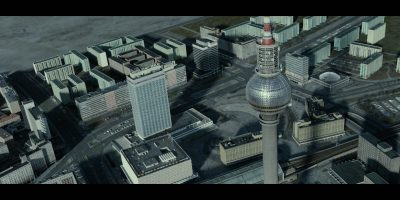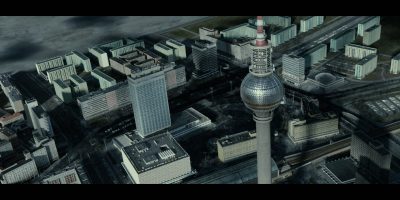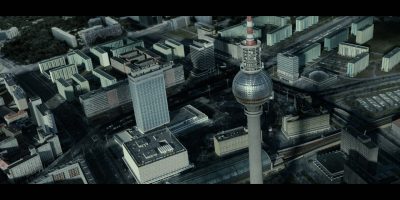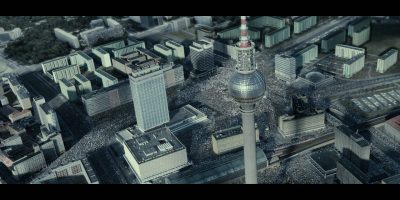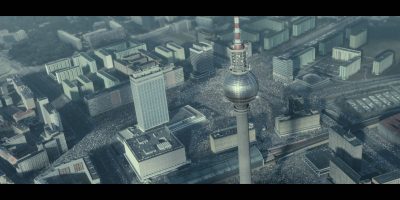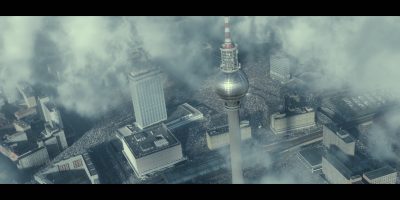In 1989, Berlin was a city split down the middle. An unpopular wall had dissected East and West for the past 26 years. Dangerous protests and increasingly volatile social conditions existed as gangs fought for control in the many sectors of the metropolis. More invisible still were the political maneuvers tearing their way through the last days of the Cold War.
In David Leitch’s Atomic Blonde, Charlize Theron plays a veteran operative working her moves in the harsh environment of East and West Berlin. The film is based on the Oni Press graphic novel The Coldest City, by Antony Johnston and illustrator Sam Hart. The coldest city is Berlin, introduced at the beginning of the story via a sweeping aerial establishing shot which culminates in street demonstrations around Alexanderplatz.
“The initial thought was to film it with a drone, but there was no possibility to get permission to fly over the Alexanderplatz,” says Ruken Baran, visual effects producer at Chimney Group. “Even if they were allowed to fly around in the skies over Berlin, it would have been 2017 Berlin of course so, we built the entire district from scratch.”
Berlin Flyover
When Leitch called for this shot, the crew knew they had a big job ahead of them. They did some solid research, gathering as many historic photos as they could. As 1989 was still before the digital age, most found images lacked quality and resolution. But luckily, the Chimney Group office was just a five minute walk from Alexanderplatz so they took repeated survey trips from vantage points like the Alexanderplatz TV tower and the former Hotel Berlin, which operates now as the Park Inn.
“We designed the flight path of the camera and, working backwards, extrapolated the thread of the shot from the match-moved B-side of the drone aerial footage of the demonstration captured in Budapest during principal photography,” says Michael Wortmann, VFX Supervisor for Atomic Blonde. “Once the flight path was locked, we tracked back and created all the buildings just from the necessary angles.”
“This vast street demonstration at the Alexanderplatz of 1989 required a district full of people in the frame as well,” says Radoslaw Jamrog, the crowd supervisor and a leading VFX artist at Chimney Group, “so again it was better to build it ourselves.” As mentioned, the last section of the aerial shot was filmed on a street set in Hungary, so they had to create a fluid transition from the CG flyover to the plate shot on set. “The crowd we added in using Golaem [crowd simulation software] and this meshed together very nicely,” says Jamrog. “In working from the zoom from the wide aerial to the street scene, the last on-set detail is the first element generated in CG.” The Chimney crew created agents with correct costumes for the weather and time, and brought in all the features of that rough Berlin streetscape.
“I think we ended up with 350,000 agents which is actually close to how many there were at the rally in 1989,” adds Wortmann. ‘We added period cars, birds and chimney smoke to the shot and worked that transition between full CG and plate for quite some time. Even though Atomic Blonde is not a documentary, this shot is really accurate to what Alexanderplatz looked like on that day, five days before the wall came down.”
“The cinematographer John Sela worked very closely with the Production Designer David Scheunemann to ensure the coldest city looked exactly that,” explains Ruken Baran. “These references rolled out onto matte painting, 3D backgrounds and the lighting, perfectly matching that color and style of the day.”
Berlin progression stills
Fights
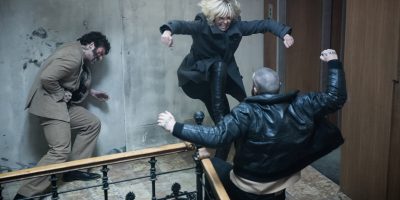
The other great challenges for the Chimney VFX crew was working with the long shots of full-on fighting between Charlize Theron’s Lorraine Broughton character and those sent to eliminate her. No doubt about it, the fight scenes in Atomic Blonde are tough. Fought in close-quarters, they are physically exhausting. They seem completely full-contact, injuring and one scene is almost ten minutes long.
All the injury makeup is practical, but the VFX combined everything into a long sequence which rolled with the story of each fight. Fighting in a stairwell during one of the signature skirmishes in Atomic Blonde, Charlize Theron, her stunt double Monique Ganderton and the groups of assassins are right in the thick of it.
“The whole stairwell fight sequence was shot chronologically with some additional second unit days after the first unit finished,” explains Wortmann. “The location was prepared for the shoot weeks before so it could be used for rehearsal. The editor, Elisabet Ronaldsdottir captured every take on set and put it together to check if the stitching [between angles] would work.”
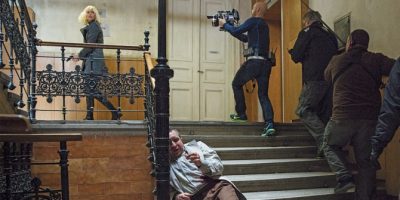 When there was doubt, Wortmann would advise how to improve the next take and make sure they worked. All kinds of techniques were used, some stitches are simple cuts, others involved some rotoscoping and others are really extensive. “We didn’t use a motion control rig but a hand operated Alexa Mini,” he explains. “I think we ended up with around 36 segments giving us a seamless nine minute sequence in the movie.”
When there was doubt, Wortmann would advise how to improve the next take and make sure they worked. All kinds of techniques were used, some stitches are simple cuts, others involved some rotoscoping and others are really extensive. “We didn’t use a motion control rig but a hand operated Alexa Mini,” he explains. “I think we ended up with around 36 segments giving us a seamless nine minute sequence in the movie.”
There were mats and nets covering all the open voids of the staircase, and the walls. Chimney then had to replace those mats with the final walls. There were close-quarter gun muzzle flashes and blood splatters, all part of the job as well. “I had one artist leading the sequence and putting together all the stitches and a whole army of additional compositors dealing with all the blood, guns, retouches, bullet holes and other retouches to match the individual segments,” he says. “At one point we stopped doing versions and switched to replacing frame ranges as it just took too long to render a Quicktime to review. This scene is so packed with action that we would find new things to tweak in every review even over eight months of production.”
“Charlize Theron performed a lot of the stunts herself,” says Wortmann. “It was impressive to see how she would repeat a take for a fight 18 times until it was finally the way Leitch wanted it. There is maybe half a dozen shots in the movie where she was body-doubled but we never digitally replaced her face onto a stunt double.”
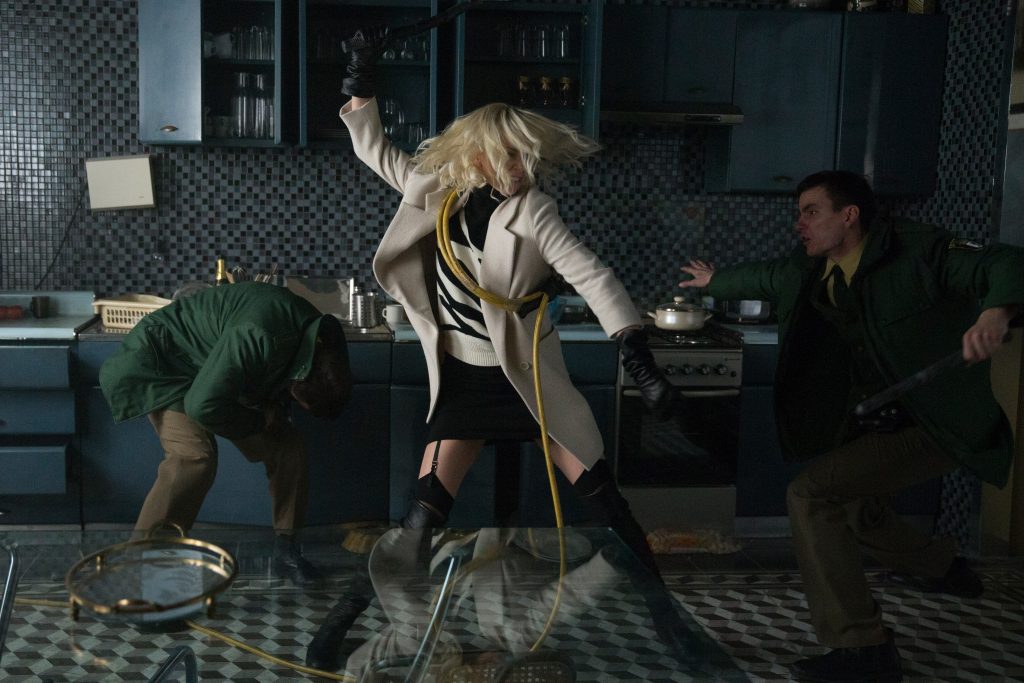
Car Chases
From the moment Theron’s character arrives in Berlin, there is action. The car chase sequences through the city were some of the first challenges for the shoot in Budapest. The scene of the car being flipped and thrown into the river was tackled on the first day of shooting. They found a swimming pool in Budapest which was wrapped in a green screen that was then replaced with plates shot during the shoot in Berlin. “When we received the footage, there was a lot of supporting rigs, wires and scuba divers that needed to be removed,” explains Baran. “The chase through the streets is filmed inside the car, from all angles in fact.”
“The car rig was a custom-built monster with all kinds of special rigs,” continues Wortmann. “The camera rig was similar to the one used in Children of Men and completely hand-operated. There were three guys in the trunk, the driver and the camera operator on top of the car and one more guy somewhere at the back. The windshield could be let down for camera positions outside, and the seats could be lowered if the camera was doing a profile shot. One actor would lie down and come up again during the take as the camera panned around. We had some takes that had green screens mounted to the car resulting in realistic lighting throughout the sequence.”
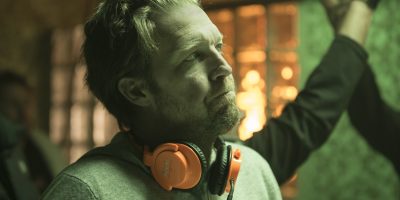
Director David Leitch is a former stunt coordinator and stuntman. He is also one of those directors who likes to do as much as he can ‘in-camera’. When the cars are crashing together, these collisions are played out as much as possible on set. Eddie Morrison and Charlize Theron were in the car as the windows shatter when the bullets hit.
As mentioned, almost the entire movie was shot in Budapest, and only a small Atomic Blonde second unit crew sent to Berlin for four or five days for pick up background material. A lot of this were shown flashing past during car chases and out windows, but most of the landmarks like the Brandenburg Gate were entirely CG, crafted by the Chimney Group modelers. Building part of the Berlin Wall was also required for some exteriors, with the matte painting of 1989 Alexanderplatz in the background. Splashed with the music of the day, including David Bowie, Blondie and The Clash, this is a spy story with a few more blood spots and bruises than a Bond thriller.

